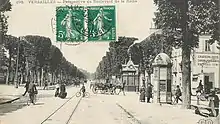Ulmus × hollandica 'Dumont'
The hybrid elm cultivar Ulmus × hollandica 'Dumont' was a very vigorous elm raised from a tree discovered by a gardener on the estate of M. Dumont at Tournay, Belgium, c. 1865.[1]
| Ulmus × hollandica 'Dumont' | |
|---|---|
| Hybrid parentage | U. glabra × U. minor |
| Cultivar | 'Dumont' |
| Origin | Belgium |
Description
The tree had a straight trunk and a narrow regular, pyramidal crown, Elwes likening it to Wheatley Elm in habit.[2] The leaves were somewhat smaller than those of 'Belgica'.[3]
Pests and diseases
'Dumont' was very susceptible to Dutch elm disease.
Cultivation

No specimens are known to survive. The tree was once a popular choice for street planting in Belgium and France, notably at Ypres, where Henry collected a specimen for Kew Gardens in 1912,[4] and at Versailles (town, not palace), where it was supplied by Moser's nursery and planted in "peculiar clipped avenues".[2] Early 20th-century photographs of the Place Barascude and Avenue Thiers, Versailles, show Wheatley-like elms, some clipped, and pruned avenues by Moser's nursery.[5][6] An U. campestris Dumont, "a vigorous grower" with "large leaves", appeared in the 1909 catalogue of the Bobbink and Atkins nursery, Rutherford, New Jersey.[7] The Hesse Nursery of Weener, Germany, marketed an Ulmus latifolia Dumont in the 1930s.[8]
Synonymy
References
- Green, Peter Shaw (1964). "Registration of cultivar names in Ulmus". Arnoldia. Arnold Arboretum, Harvard University. 24 (6–8): 41–80. Retrieved 16 February 2017.
- Elwes, Henry John; Henry, Augustine (1913). The Trees of Great Britain & Ireland. 7. pp. 1871–1872.
- "Famille XV – Ulmacées". Annales des travaux publics de Belgique. 62: 1226. 1905.
- Ulmus belgica Burgsd. ex Rehder var. dumontii A.Henry, apps.kew.org, specimen K000852722
- Place Barascud (Barascude), Versailles, and Pépinière du Moser, 'Les quartiers de Versailles', cartophilie-viroflay.org
- Tramway de Saint Cyr au square Barascude, cparama.com
- Bobbink and Atkins, Rutherford. N.J. 1909. p. 51.
- Hesse, Hermann Albert (1932). Preis- und Sortenliste. pp. 96–97. Retrieved 18 January 2018.
- Mottet, Séraphin Joseph Mottet; Nicholson, George (1898). Dictionnaire pratique d'horticulture et de jardinage. p. 383.
External links
- "Ulmus belgica v. Dumontii". Herbarium catalogue. Board of Trustees of the Royal Botanic Gardens, Kew. Retrieved 17 October 2016. Ypres specimen (Augustine Henry, 1912)
- "Herbarium specimen - L.1587068". Botany catalogues. Naturalis Biodiversity Center. Long shoot, possibly juvenile; U. hollandica Mill. 'Dumonti'; Poort Bulten Arboretum specimen, Den Haag (1931)
- "Herbarium specimen - WAG.1847159". Botany catalogues. Naturalis Biodiversity Center. Long shoot, possibly juvenile; U. hollandica Mill. 'Dumontii' Rehd.; Den Haag specimen (1932)